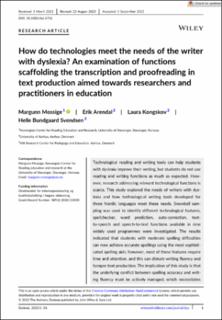| dc.contributor.author | Mossige, Margunn | |
| dc.contributor.author | Arendal, Erik | |
| dc.contributor.author | Kongsskov, Laura | |
| dc.contributor.author | Svendsen, Helle Bundgaard | |
| dc.date.accessioned | 2023-12-04T13:51:49Z | |
| dc.date.available | 2023-12-04T13:51:49Z | |
| dc.date.created | 2023-09-25T13:45:15Z | |
| dc.date.issued | 2023-09 | |
| dc.identifier.citation | Mossige, M., Arendal, E., Kongsskov, L. & Svendsen, H.B. (2023) How do technologies meet the needs of the writer with dyslexia? An examination of functions scaffolding the transcription and proofreading in text production aimed towards researchers and practitioners in education. Dyslexia, 29(4), 408-425 | en_US |
| dc.identifier.issn | 1076-9242 | |
| dc.identifier.uri | https://hdl.handle.net/11250/3105857 | |
| dc.description.abstract | Technological reading and writing tools can help students with dyslexia improve their writing, but students do not use reading and writing functions as much as expected. However, research addressing relevant technological functions is scarce. This study explored the needs of writers with dyslexia and how technological writing tools developed for three Nordic languages meet these needs. Snowball sampling was used to identify different technological features, spellchecker, word prediction, auto-correction, text-to-speech and speech-to-text functions available in nine widely used programmes were investigated. The results indicated that students with moderate spelling difficulties can now achieve accurate spellings using the most sophisticated spelling aids; however, most of these features require time and attention, and this can disturb writing fluency and hamper text production. The implication of this study is that the underlying conflict between spelling accuracy and writing fluency must be actively managed, which necessitates competence in the use of technological tools for both students and teachers in school. Also, further development of tools for scaffolding transcription must consider the dilemma of achieving both writing fluency and spelling accuracy. Further, the accuracy of the aid for students with severe spelling difficulties remains unclear and must be investigated. | en_US |
| dc.language.iso | eng | en_US |
| dc.publisher | John Wiley & Sons Ltd. | en_US |
| dc.rights | Navngivelse 4.0 Internasjonal | * |
| dc.rights | Navngivelse-Ikkekommersiell 4.0 Internasjonal | * |
| dc.rights.uri | http://creativecommons.org/licenses/by-nc/4.0/deed.no | * |
| dc.subject | utdanningsvitenskap | en_US |
| dc.subject | dysleksi | en_US |
| dc.subject | dyslexia | en_US |
| dc.title | How do technologies meet the needs of the writer with dyslexia? An examination of functions scaffolding the transcription and proofreading in text production aimed towards researchers and practitioners in education | en_US |
| dc.type | Peer reviewed | en_US |
| dc.type | Journal article | en_US |
| dc.description.version | publishedVersion | en_US |
| dc.rights.holder | © 2023 The Authors | en_US |
| dc.subject.nsi | VDP::Samfunnsvitenskap: 200::Pedagogiske fag: 280::Spesialpedagogikk: 282 | en_US |
| dc.source.pagenumber | 408-425 | en_US |
| dc.source.volume | 29 | en_US |
| dc.source.journal | Dyslexia | en_US |
| dc.source.issue | 4 | en_US |
| dc.identifier.doi | 10.1002/dys.1752 | |
| dc.identifier.cristin | 2178606 | |
| cristin.ispublished | true | |
| cristin.fulltext | original | |
| cristin.qualitycode | 2 | |

